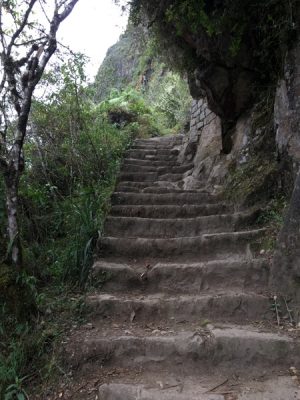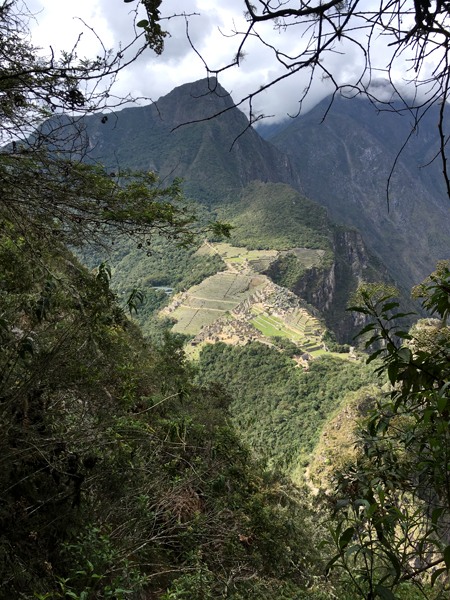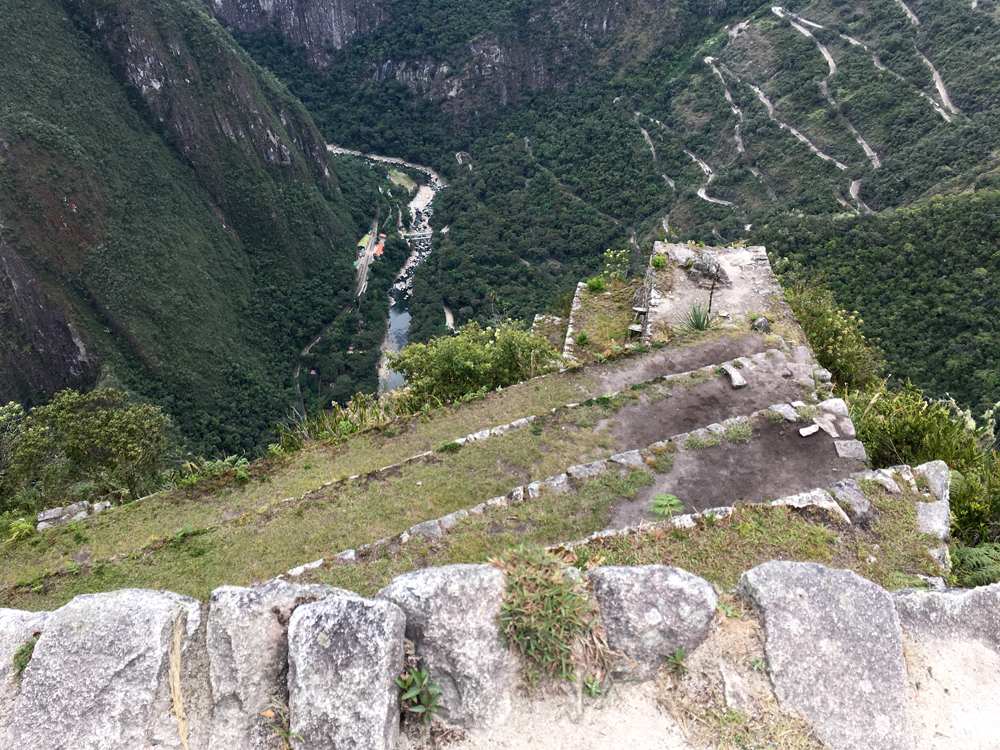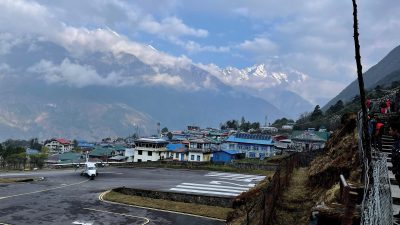Home / Latin America & Antarctica / The Exhilarating Thrill of Cli…

The Exhilarating Thrill of Climbing Huayna Picchu on Peru Travel
I hate heights, but I loved climbing Huayna Picchu. You may not recognize the name, but you’ve definitely seen the mountain, as it adorns the background of almost every single picture of Machu Picchu. If you look at the iconic image of Peru’s famous Incan citadel, you’ll see the ruins in the foreground with a steep mountain right behind the ruins in the background – that’s Huayna Picchu. And although most people may be daunted by the sight of it or not even know that you can climb it, you most definitely can and should, if you have the stamina. Take it from a man who hates heights… on my Peru travel, climbing Huayna Picchu was an exhilarating rush.
How to Go About Climbing Huayna Picchu
The simplest way to organize a climb is to get a guide. I know, I know! It’s a common refrain in travel articles to recommend a private guide, but this is a situation where a guide makes everything better. For one thing, Huayna Picchu is steep and you’ll want the assurances of having someone who has climbed it before leading the way. Furthermore, you need to acquire a ticket to climb the mountain beforehand, and that ticket will have a scheduled climb time, which you must adhere to. There’s paperwork that goes with the ticket, so why bother with the hassle when your guide can arrange everything for you? This means all you have to worry about is being in the right physical state to complete the climb.
If you happen to chance it alone and you’re dawdling and you arrive at the gate to Huayna Picchu at a different time than your scheduled climb or with your paperwork not in order, don’t expect the rangers to let you through. They can be a persnickety bunch and have no time for travellers trying to bend the rules of a visit to their sacred mountain. But if you follow the rules, show up at the proper time, and climb in an orderly fashion, everything should go smoothly.

That means that in preparation, all you should worry about is hitting the Stairmaster at the gym, before your Peru travel, because climbing the steep, ancient stairs up the mountain will require a lot of effort. But believe me, it’s worth it.
Ascending the Young Mountain
The actual process of climbing Huayna Picchu is fairly straightforward. After arriving at the gate at your allotted time, the rangers will check your paperwork and passports, make sure everything is in order, and then send you along to begin the climb. The first leg of the trail is relatively flat, eventually leading you to a crossroads where you can choose the short or long version of the hike. The long version skirts the mountain and takes you to the Temple of the Moon, which lies on the other side of the mountain. It adds at least an hour and a half to your journey, but lets you see the temple, which is carved out of the rock and another stunning example of Incan ingenuity. It’s also much-less frequented than the main Huayna Picchu trail, so if you’re into seeing highlights most people miss on Peru travel, you should take the time to see it.

I skipped the hike to the Temple of the Moon as I was suffering from a cold during the hike, but I would’ve done it had I had more energy. Instead, I stuck to the main path and began the hour or so climb to the top of the mountain. The steps are extremely steep and old, so you have to take it slow and keep sure footing while you ascend. As well, there isn’t any room to ascend two abreast, so if people are coming back down the stairs, you’ll have to find a little outcropping to the side and let them pass. Same goes for people who are moving quicker than you coming from behind. Move to the side and let them pass or just keep at your steady pace and let them slow down.
The ascent is physically demanding, but not impossible and hardly requires you to be in anything resembling marathon shape. Remember, I climbed Huayna Picchu while suffering from a nasty cold and battling my usual fear of heights, so believe me that if I can do it in these conditions, you can likely do it too. Just be sure of your footing, don’t rush, and take it one step at a time. Don’t be afraid to use your hands to help yourself up and don’t feel pressured to speed up because some adrenaline junkie is coming up hot on your heels. They can be patient or pass you when the trail widens.
Views from the Top

Eventually, after an hour or so depending on the pace of your climb, you’ll start to reach the terraces constructed on the top of the mountain. This is where the fun begins, since you’ll find the steepest steps of the whole climb at the bottom of the terraces. What makes them difficult to ascend is the lack of railing or cliff-side to help you balance as you walk up them. But with some patience and some balance, you’ll make it and reach the terraces, which were used as farming plots by the Incas over 500 years ago. (Imagine a farmer having to climb the whole mountain each day just to get to his field. The dedication of the Incas was incredible.)
Once you reach the top of the terraces and the actual top of the mountain, you’ll enjoy some of the best views of Machu Picchu. What makes this perspective of the ruins so special is that it’s almost never advertised in photos or write-ups about the mountain. On Peru travel, most people only ever see Machu Picchu from the south, looking from the Sun Gate, the ledge at the House of the Guardian to the Funerary Rock, or the peak of Machu Picchu Mountain, with Huayna Picchu in the background. The north view from Huayna Picchu gives you a whole new perspective, as it lets you appreciate the cascading terrace structure of the ruins, as well as the sheer size of the citadel.

If you’re lucky, once you get to the top of the mountain, you’ll have a minute or two to climb the massive boulders that sit on the top of the mountain and look out from the highest point. The views of Machu Picchu are great from up here, but so are the views of the surrounding cloud-draped mountains. If you’re into Instagram posts, this is also a good spot to take a photo of you lying on your back on the rock at such an angle that nothing but Machu Picchu and the clouds are your surroundings. If you enjoy trick perspective shots, you can even make it seem like you’re pitched on the edge of a terrifying precipice here, a few centimetres from falling off the edge of the mountain, which in actual fact, you’ve got several terraces just below you.

Heading Back Down
After enjoying your moment on the rocks, the rangers will tell you to keep moving and you’ll start your descent, first passing through a narrow cave where you’ll have to crouch and slide between the massive rocks. After that, you follow a descent along the left side of the terraces, which is arguably the most dangerous part of the whole climb, as you’re going down steps that are extremely narrow with no hand support. Take it slow. You’ll get down eventually. Soon enough you’ll get back to the crossroads where people are coming up, while others are going back down.
It’s then back down the way you came up. Often descending a mountain is harder than climbing it. For one thing, you’re more tired than you were at the start. Furthermore, it may not be as exhausting to descend, but it requires more balance and patience, since it’s easier to lose footing going down. The advantage of going down is that you’re more aware of the view, since you’re facing away from the mountain, not towards it. Take advantage of the opportunity to take some photos you missed on the way up. And again, take your time. This isn’t a contest to see who can get up and down Huayna Picchu the fastest. If people are stalking your heels, let them pass and keep going at a steady pace. Enjoy the descent and the views. Odds are, you may never be on this mountain again so take full advantage of the experience while on Peru travel.

Climbing Huayna Picchu adds a bit of adventure to the already-spectacular experience of visiting Machu Picchu. It takes some time and a lot of physical effort to do it, but it’s worth it, not only for the beautiful views from the top, but also for the excitement of what an achievement it is. If you’re visiting Machu Picchu and don’t mind a challenge, make sure to climb Huayna Picchu. You’re missing out on an unforgettable experience if you don’t.
Get more travel inspiration by email.
Subscribe
0 Comments

Get the latest travel trends & hear about the best deals on vacations around the world.
If you’re a Globetrotter, these are the newsletters for you!



